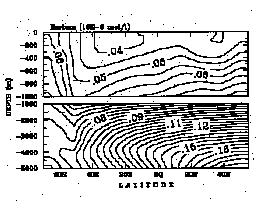
Enhanced deposition of barium in sediments is usually attributed to increased productivity in the overlaying surface waters. However, sediments from the Ontong Java Plateau in the western equatorial Pacific show enhanced sedimentary fluxes of barium during changes from glacials to interglacials whereas other proxies give no evidence for enhanced productivity at these times (Schwarz et al., 1996). One possible explanation for this paradoxon is that these barium maxima reflect climatic induced changes of ocean circulation. For example, benthic foraminifera show increased barium concentrations in the deep Atlantic and decreased concentrations in the deep Pacific during the last glacial maximum (Lea and Boyle, 1990). The onset of the thermohaline circulation would carry Ba-enriched Atlantic deep water into the Pacific Ocean where it could be sedimented.
For a better understanding of the barium sedimentary record and the changes in sedimentary fluxes, we modelled the present distribution of barium in sea water using a zonally-averaged global ocean circulation model developed by Wright and Stocker (1991). The model assumes that particulate barium is produced in the water column by uptake of barite into sinking organic particles. Redissolution of barium occurs in the deep water column and at the surface of the sediments. Good agreement with the observations can be obtained when the formation of particulate barium is parameterized as a function of primary productivity in the surface waters, barium concentration in the water column and water depth.
We present results of numerical experiments in possible glacial modes, which generate peaks of barium at the climatic transitions as observed in the sediment record.
Lea, D. W. & Boyle, E. A., Paleoceanography 5, 719-742 (1990).
Schwarz, B., Mangini, A. & Segl, M., Geologische Rundschau, (1996, in press).
Wright, D. G. & Stocker, T. F., J. Phys. Oceanogr. 21,1713-1724 (1991).
Fig. 1: Model Barium distribution in the Pacific Ocean for present day conditions.